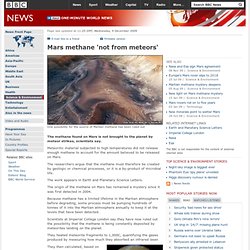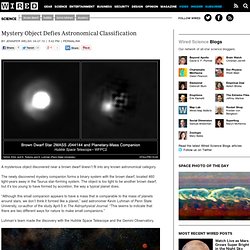

Asteroid. Apophis. Mars methane 'not from meteors' One possibility for the source of Martian methane has been ruled out The methane found on Mars is not brought to the planet by meteor strikes, scientists say.

Meteoritic material subjected to high temperatures did not release enough methane to account for the amount believed to be released on Mars. The researchers argue that the methane must therefore be created by geologic or chemical processes, or it is a by-product of microbial life. The work appears in Earth and Planetary Science Letters. The origin of the methane on Mars has remained a mystery since it was first detected in 2004.
Because methane has a limited lifetime in the Martian atmosphere before degrading, some process must be pumping hundreds of tonnes of it into the Martian atmosphere annually to keep it at the levels that have been detected. Scientists at Imperial College London say they have now ruled out the possibility that the methane is being constantly deposited by meteorites landing on the planet. Venus. Want to stay on top of all the space news?

Follow @universetoday on Twitter Venus Cloud Tops Viewed by Hubble Venus is the second planet from the Sun and is located between Mercury and the Earth. The planet has been known to exist since ancient times. Aside from the Sun and the Moon, it is the brightest object in the sky. The average distance from Venus to the Sun is 108.21 million km. Venus takes 224.7 days to complete one orbit around the Sun. Scientists consider Venus to be a twin of Earth because of its many similarities. A day on Venus lasts 243 days; which is unusual considering the fact that a year on Venus is only 224.7 days. Radar imaging of Venus’ surface has shown that it does have impact craters around the planet, and evidence of wide scale volcanism. Although Venus has many similarities to Earth, it has some enormous differences. At one time scientists and science fiction writers alike thought that the surface of Venus was tropical in nature.
Venus has no moons or rings. Kuiper Belt world measured in star pass. 16 June 2010Last updated at 19:46 By Katia Moskvitch Science reporter, BBC News The Kuiper Belt is home to several dwarf planets, one of which is Pluto Astronomers say they have observed, for the first time, a distant icy world orbiting beyond Neptune as it passed briefly in front of a bright star.

This "stellar occultation" occurs when a planetary body hides a star as it moves across the sky. Mystery Object Defies Astronomical Classification. A mysterious object discovered near a brown dwarf doesn’t fit into any known astronomical category.

The newly discovered mystery companion forms a binary system with the brown dwarf, located 460 light-years away in the Taurus star-forming system. The object is too light to be another brown dwarf, but it’s too young to have formed by accretion, the way a typical planet does. “Although this small companion appears to have a mass that is comparable to the mass of planets around stars, we don’t think it formed like a planet,” said astronomer Kevin Luhman of Penn State University, co-author of the study April 5 in The Astrophysical Journal.
“This seems to indicate that there are two different ways for nature to make small companions.” Luhman’s team made the discovery with the Hubble Space Telescope and the Gemini Observatory. The new object and its companion brown dwarf are orbiting as a binary pair, 15 astronomical units from each other. Images: 1) NASA, ESA, K. UK researchers have developed a device to drag space junk out of orbit. The CubeSail mission would expect to operate for about a year UK researchers have developed a device to drag space junk out of orbit.

They plan to launch a demonstration of their "CubeSail" next year. It is a small satellite cube that deploys a thin, 25-sq-m plastic sheet. Residual air molecules still present in the spacecraft's low-Earth orbit will catch the sheet and pull the object out of the sky much faster than is normal. The Surrey Space Centre team says the concept could be fitted to larger satellites and even rocket stages. The group also envisages that a mature system would even be sent to rendezvous and dock with redundant spacecraft to clean them from orbit. "Our system is simple and very low cost; but we need to demonstrate that it can be done," said Dr Vaios Lappas, lead researcher on the project and senior lecturer in space vehicle control. "It would help make space a sustainable business. Simplicity of approach Force of sunlight. Russia 'plans to stop asteroid' The head of Russia's federal space agency has said it will work to divert an asteroid which will make several passes near the Earth from 2029.

Anatoly Perminov told the Voice of Russia radio service that the agency's science council would hold a closed meeting to discuss the issue. Any eventual plan is likely to be an international collaboration, he said. The US space agency said in October that there is a one-in-250,000 chance of Apophis hitting Earth in 2036.